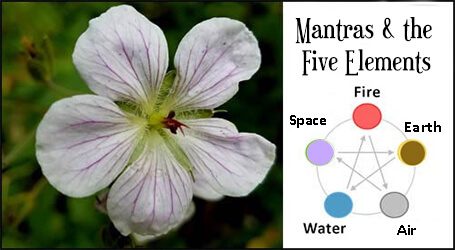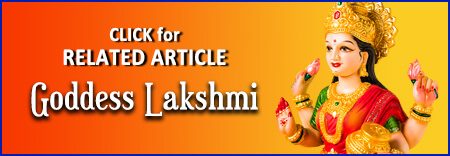Watch nearly 400 videos on the Vocal Medicine Channel!
Wealth Mantra: Bija Seed Syllable Shrim
“Shrim” is one of the most powerful and commonly used of the bija mantras, also known as Sanskrit seed syllables. Seed syllables are the sounds believed to be most closely associated with the fundamental energies of creation. Seed syllables are often used in mantras for a particular purpose. “Shrim” means “splendor” and is associated with wealth of all kinds.
Share this page with a friend!
Shrim & the History of Mantra Yoga
Shrim is one of the eight primary seed syllables mentioned in the ancient text called the Mantra Yoga Samhita, translated and edited by Ram Kumar Rai. This text defines Mantra Yoga as one of the four basic forms of yoga: Hatha, Laya, Raja and Mantra.
- Hatha Yoga is dedicated to physical techniques to preserve and direct life energy in the body.
- Laya Yoga is a form of meditation with concentration on the chakras or energy centers.
- Raja Yoga consists of eight stages of mind and body control.
- Mantra Yoga utilizes sound and emotion in the form of devotional singing and mantras.
Eight Primary Bija Seed Syllables
The eight primary bija mantras focus the energy of creation in specific ways. This is the shakti energy, a term for the unformed energy of creation. This energy is usually viewed as feminine. The eight syllables are OM, AIM, HRIM, KLIM, KRIM, SHRIM, TRIM and STRIM. Learn more about the seed syllables in the article One Word Mantras.
Learn more in our Five Element Mantras article!
Shrim & the Five Elements
Mantras can also be divided into five predominant categories based on the five elements: water, fire, earth, wind and ether or space. The five elements are categories of energy transformation. Individuals and all phenomena in nature can be assigned to one of these categories based on their affinity with these elements.
Shrim as the Light of the Moon
Shrim is mainly related to the earth and water elements, with some fire qualities. Shrim is a gentle light, closer to the light of the moon than the light of the sun. This energy is like luster or glow rather than a blazing fire. The water and earth elements help to soothe the mind and improve health and fertility. Shrim assists in reproductive health, especially for women.
Benefits of Shrim for the Heart
Shrim is related to the feeling nature of the heart rather than the functional nature. In contrast with this, the seed syllable “hrim” is for the physical aspects of the heart. The bija seed syllables as a whole are viewed as feminine energy. They are sometimes referred to as shakti mantras. Shakti refers to the unformed energy of the universe waiting to be solidified in physical form.

Shrim Meaning: Abundance and Creativity
Shrim brings positive growth and development. This shakti mantra attracts energy, situations and people who are beneficial for our lives. This is the syllable of surrender and devotion. Shrim includes the concept of faith and refuge in a chosen aspect of God.
Components of Shrim
Shrim is alternately spelled shreem or srim. The letters in bija syllables are combined to direct either a sustaining or dissolving energy. For example, the letters “S” and “SH” are a soft energy, therefore often associated with water and goddess energy. The “R” in shrim connects to fire and light. The “IM” or “EEM” is the sound of intention, energy, focus and motivation.
Sound of the Divine Mother
The “M” is indicative of transformation and connects to source or creation as the Divine Mother. “M” is used in many words and languages to indicate a mother: ma, mamma, mommy, mom, mother, mum, mummy, madre, mere, mam, amma, mutter, matka and more.
Shrim and Astrology
The combination of sounds in shrim carry the frequencies of career, financial gain, success and the fulfillment of one’s mission or deepest longing. In the realm of astrology, shrim can strengthen positive aspects of Venus and Jupiter as well as the moon. Learn more in the Astrology Mantras article.
Shrim Mantra for Wealth
The lyrics for this mantra are “OM HRIM SHRIM Lakshmi Bhayo Namaha. ” This mantra clears out unwanted energy in your life to create room for abundance. This mantra is useful for opening the heart to new possibilities and experiences. “Bhayo” means “blessings.” The full mantra means “Lakshmi, reside in me and bestow thy abundance on all aspects of my existence.”
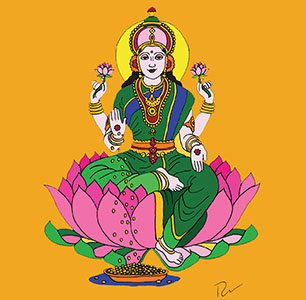
Shrim & the Goddess Lakshmi
Shrim is the bija mantra most associated with the goddess Lakshmi, the personification of all that is good, helpful and beneficial. Lakshmi is the consort of Vishnu, one of the three deities in the Hindu trinity. The bija seed syllables can be used as single word mantras. Learn about other powerful seed syllables in One Word Mantras.
Vishnu, Consort of Lakshmi
Vishnu has the role of the preserver, whereas Brahma is the creator and Shiva is the force of dissolution. Vishnu has many incarnations, including Ram or Rama. Shrim is also viewed as a bija seed syllable for Rama. Learn more about Lakshmi and listen to one of her mantras below.
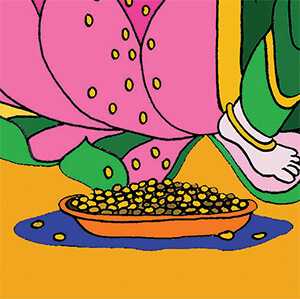
Dispensing Gold Coins
Lakshmi, the Hindu goddess of wealth, is usually shown seated or standing on a lotus. The lotus symbolizes creation, beauty, harmony, diversity, stability, and support. Lakshmi also holds lotus flowers in each hand. She dispenses gold coins from one of her other four hands.
Symbol of the Abundance of Food
Sometimes Lakshmi dispenses rice from her other hand, symbolizing an abundance of food. The rice lands in a bowl of gold coins set just in front of her. In addition to being the Hindu goddess of wealth, Lakshmi also appears in Jainism and Buddhism. The name Lakshmi is derived from a Sanskrit word meaning goal, aim or sign.
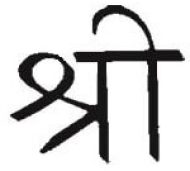
Use of SHRIM Mantras
As the goddess of wealth, Lakshmi is understandably an extraordinarily popular goddess. Her seed syllable shrim is viewed in Ayurveda (Eastern medical system) as a mantra for health, happiness and fertility. Shrim is a lunar versus a solar energy. This helps to calm down and balance excess heat and activity.
Shrim Connection to Lunar Energy
Because of the connection to lunar energy, shrim is ideal for evening mantra practice. Some think that using shrim in the evening will aid sleep and dreaming. Shrim has relaxing and nurturing qualities and brings feminine energy and power into our lives.
Shrim and the Chakras
Some mantra practitioners recommended doing a set of 108 repetitions of a mantra, possibly repeated for 10 days or a month. A few of the more well-known mantras to Lakshmi utilizing the shrim shakti syllable are included below. This seed syllable is believed to activate both the third eye chakra (ajna chakra) and the crown chakra (sahasrara chakra).
Shrim and the Third Eye Chakra
The third eye chakra is the sixth chakra, counting from the base or root chakra at the bottom of the spine. This chakra is the seat of spiritual vision. The third eye is associated with perception, intuition and insight. The Sanskrit term “ajna” means to “command” or “perceive.”
Locating the Third Eye
The vibrations of chanting and singing are felt in the skull and can be consciously directed to the third eye chakra. The superficial location of the third eye is between the eyebrows at the bridge of the nose. All of the bija seed syllables that use the sound “EE” are stimulating for the third eye. Thi, of course, is true for the bija syllable shrim.
Third Eye and Pineal Gland
The pineal gland is associated with this chakra. The third eye, usually connected with clairvoyant abilities, can be developed with yoga, meditation and the practice of chanting. In practical terms, the third eye can be viewed as the center of creation and imagination. Learn more in a full article on the Third Eye Chakra.
Shrim and the Crown Chakra
The seventh chakra is the crown chakra, the seat of enlightenment, known in Sanskrit as the Sahasrara chakra. Sahasrara means “thousand-petaled.” According to Eastern traditions, the crown chakra is related to god-consciousness (samadhi) and the transforming powers of the divine. Sometimes a blocked or imbalanced crown chakra is said to be associated with accidents and unexpected life events.
Crown as a Cluster of Chakras
The crown chakra is sometimes thought to be a combination of a cluster of chakras on the skull, such as the back of the head where monks may gather their hair or shave a bare spot. The crown can be viewed as the father, or spirit energy. This draws the mother, or earth energy, from the lower chakras upward. The seed syllable shrim is useful in this process.
Shrim Stimulates the Brain and Skull
Shrim assists in the connection through the crown to the Divine Self. Many of the seed syllables reverberate in the skull, stimulating the brain and the endocrine glands associated with the brain. Learn more in the article Crown Chakra Meaning.
Mantra for the Heart Using SHRIM
After OM, Vedic mantras for the chakras focus on the seed syllable for the intended chakra. In this case, “yam” is the seed syllable for the heart chakra. Shrim follows after that, adding the vibration of abundance, expansiveness and joy.
The Meaning of “Namah”
The mantra closes with the word “namah.” This word is usually translated as “I bow,” “I give reverence,” “salutations” or “I honor.” A full translation would be something like: “I give honor to the abundance of the heart.”
Mahalakshmi Mantra
This mantra is a powerful combination of seed syllables (OM, SHRIM and HRIM) with variations on the names of Lakshmi. The tile “Mahalakshmi” combines the word “maha” meaning “highest” with Lakshmi’s name. The mantra also uses two additional names for Lakshmi. These names are Kamala and Preseeda.
Chanting the Names of God
The practice of mantras or kirtan is sometimes defined as the chanting of the names of God. Mantras which include multiple names for a god or goddess are common. In this case, Kamala means the lotus or pale red and “Preseeda” means the one who is kind, benevolent, happy and elated. Thus, this mantra honors Lakshmi as the Goddess Kamala. As a result, it is often called the Goddess Kamala Mantra.
Lyrics: Om Shrim Hrim Shrim; Kamale Kamalale Om; Namaha Praseeda, Preseeda; Shrim Hrim Shrim Om; Mahalakshmiyei Namaha
Other Shrim Mantras
Other mantras also include variations on the name of Lakshmi combined with the seed syllable shrim. The importance of this seed syllable and of Lakshmi is evident in Hinduism. Lakshmi is part of the Tridevi, a trinity of goddesses. These three goddesses parallel the male trinity of Vishna, Brahma and Shiva.
Trinity of Goddesses
Along with Lakshmi, the Tridevi includes Saraswati (consort of Brahma) and Parvati (consort of Shiva). The seed syllables for Saraswati (AIM) and Parvati (HRIM) combine with Lakshmi’s to create a trinity of shakti (goddess) one word mantras: AIM, HRIM and SHRIM.
Author Kathleen Karlsen
Kathleen Karlsen is a musician, artist, writer and speaker. She is the author of two books (Flower Symbols and Vocal Medicine) and over 200 articles. Kathleen, her husband Andrew, and their five children live in Bozeman, Montana. More about Kathleen Karlsen.
SHRIM Article Summary
This article covers the seed syllable SHRIM. Shrim is one of the most powerful and commonly used of the biji mantras or one word mantras. Seed syllables are the sounds believed to be most closely associated with the fundamental energies of creation. This article includes a discussion of the role of mantra yoga, the relationship between the five elements and shrim, the connection to the goddess Lakshmi and selected mantras featuring the word shrim.

